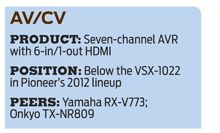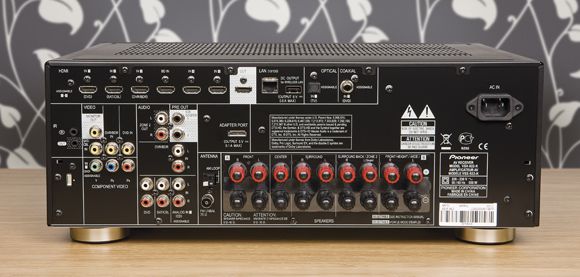Pioneer VSX-922 review

 May saw Pioneer doing its traditional launch of a new range of AV receivers. As usual, the lower- and mid-range models break cover first – and the VSX-922 is one of the latter.
May saw Pioneer doing its traditional launch of a new range of AV receivers. As usual, the lower- and mid-range models break cover first – and the VSX-922 is one of the latter.
Last season’s VSX-921 bagged the EISA award for best European Home Theatre Receiver, and the Japanese brand will hope the VSX-922 can be in the running for the same accolade. This new contender is not a radical departure, however. It’s best described as just a lightly fettled and updated version of last year’s receiver. If it ain’t broke don’t fix it.
The key premise of Pioneer’s latest receivers is mating potent processing and beefy power with seamless network integration. Not exactly a new concept, I grant you, but one which Pioneer has polished to perfection better than any other brand to date. It matters not whether you want to use a standard HDMI input, AirPlay, an Apple i-device, USB or DLNA server – the VSX-922 treats them all like normal inputs and brings them together under its classy GUI, or the absolutely stunning 2012 version of the Pioneer iControlAV App.
HDMI upgradeA quick scan of the features list might make you think the VSX-922’s actual hardware has changed little, but what alterations have been made are important. Pioneer has obviously taken criticism of the VSX-921 onboard and increased the HDMI input count from four to six (all v1.4 3D-compatible). This adds immediate flexibility and will be a major bonus to most buyers.
The HDMI inputs are now each equipped with a stand-by pass through mode, too, so you can view sources without having to power up the receiver. Both Denon and Yamaha offer this on their AVRs and it’s good to see Pioneer following suit – not only can it help save on your power bill, it means fewer angry yelps from technophobe family members who want to watch TV without having to work two remote controls.
The VSX-922 has the same 7x150W claimed power output and a cosmetic appearance that could be an identical twin to its predecessor. You still get Pioneer’s excellent MCACC room EQ with Standing Wave Control, you still get the naff plastic set-up mic, and the dull remote is also virtually identical.
One major change is analogue connectivity. As a sign of the times, this has taken a nose dive. I have never seen a mid-priced AVR with so few phono sockets on the back. Does this matter to you? Probably not.
What has been upwardly revised for 2012 is predominantly in the operation and firmware. Upscaling is improved via Pioneer’s Advanced Video Adjust suite, which includes 1080p24 video conversion as well as the brand’s Stream Smoother. This enhances low bit-rate video sources, such as YouTube footage. I put it to the test with said online service, and, sure enough, found videos noticebably smoothed, making them easier on the eye with less artefacting.
The networking of the VSX-922 is simply seamless, connecting to any one of my five AirPlay sources (I’ve been Apple-ized), two DNLA servers or, using the supplied cable, the iPhone without so much as a stutter.
Return of the MCACC
 Once I’d finished faffing around on my home network, it was time to get into the fine-tuning and acoustic tweakery that is Pioneer’s MCACC, now with Phase Control and tuning for one or even two subwoofers. This receiver gets what is pretty much Pioneer’s top-of-the-line MCACC system complete with the ‘pro’ EQ setup. The process is rather long-winded compared to many of its rivals – each channel is fired up in sequence at least five times to test polarity, measure for the EQ, Phase and Standing Wave Control and then set channel levels.
Once I’d finished faffing around on my home network, it was time to get into the fine-tuning and acoustic tweakery that is Pioneer’s MCACC, now with Phase Control and tuning for one or even two subwoofers. This receiver gets what is pretty much Pioneer’s top-of-the-line MCACC system complete with the ‘pro’ EQ setup. The process is rather long-winded compared to many of its rivals – each channel is fired up in sequence at least five times to test polarity, measure for the EQ, Phase and Standing Wave Control and then set channel levels.
That is pretty much it for setup via the GUI as, for no easily explainable reason, a lot of features are only accessible from the fascia display. Pressing ‘audio parameter’ or ‘video parameter’ gets you to the lip-sync adjustment (auto and manual) and upscaling controls, for example, which I would have thought were primary functions for the GUI.
Perhaps an answer to this is Pioneer’s all-new 2012 iControl AV App. This is not an update on the old iControl AV versions (which won’t work with 2012 models, confusingly) and requires you to download a whole new app. It’s worth it, though. The iPad version of iControl AV 2012 is not just good, it is way, way ahead of every other AV kit-maker on the planet in terms of its operation, appearance, depth of control, usability and overall wow factor. Yes, all the usual operation features are in there, like selecting source and sound format, but the app adds a layer of adjustments that can only otherwise be tweaked from the front panel.
The innovative Sound Explorer tab offers a wealth of features, such as dialogue enhancement, phase control and virtual depth, presented as bouncing balloons that lock and offer dial-like adjustments when pressed. At the time of writing there’s a bug that closes the app if you attempt to look at the MCACC EQ graphs but I’m sure this will be sorted soon. Actually, the iControl AV 2012 App is so cool you could spend all night playing with it and not watch a movie. This is the template that other manufacturers should be looking to replicate.
Getting in syncOnce I had located the lip-sync delay in the fascia menu I still struggled to get sync between sound and picture. The setting resulted in a delay quite a way from ideal and made movies sound detached and unwatchable. Some tweaking of the manual adjustment was required, and by trial and error the audio and video came together. Manual lip-sync is not a huge issue and only has to be done the once but on such a techy AVR it’s a pain.
Moreover the sheer number of adjustments in the iControl AV 2012 App can get you in all sorts of acoustic bother. By the time I had my real height channels mated with virtual wides and virtual surround back channels, engaged the standard MCACC EQ, boosted the dialogue enhancement, adjusted the virtual depth to max and tweaked the variable x-curve, I ended up with a veritable dog’s dinner. And Pedigree Chum it wasn’t. The sound stage was massive, at least twice the size of my listening room, but presentation was phasey and unnatural.
Stripping everything back to basics and leaving just the EQ engaged, the Pioneer ripped into movies and music with lightning speed and a feisty, upbeat presentation. The top-end was crisp and well extended and managed to keep just on the right side of aggressive. The bottom-end was just as well extended and with stereo music (no subwoofer) the LF response was rich and fulsome with great attacking punch. Lana Del-Ray romped into the room with such authority I had to check the sub was not engaged.
But it is with movies that the VSX-922 really shines. Throughout the Alien Anthology (Blu-ray) it created a huge soundstage, epic bass effects and brought the extra-terrestrial atmosphere and tension to life. As the Alien head dribbled and breathed in big-screen close up, coming within inches of Ripley’s head, the sound was intense and tangible. The VSX-922 all but urges you to shrink into the sofa and pull a cushion up over your face.
Stepping up the pace even further with Super 8 (Blu-ray), this AVR drove the train crash into the room in an all-channel festival of effects. The main action was pulled up to centre of the screen (thanks to the height channels) and I was treated to a seamless 360-degree immersion. Sadly, the Pioneer’s presentation does nothing to enhance the twee Spielbergisms that grate in an otherwise fine film.
Inherent characterSo, playing with the many settings in the iControlAV 2012 App does add layers of enhancement, mostly space to the soundstage, but it is the Pioneer’s inherent character of speed and clarity that really shine through. Some may find it a little too clinical, too Far Eastern in its tuning, but that comes down to personal preference.
Regardless, this is clearly an AVR with a lot going for it. The extra HDMIs are welcome, the room EQ setup, though lengthy, is first-rate and the smart device control is blistering. I had a few awkward moments with it, but generally it’s a slick performer. Worth an audition.

HCC VERDICT
Pioneer VSX-922
Price: £550 Approx
Highs: Packed with features; awesome app control; fast and exciting sound
Lows: Can sound feisty with forward speakers; possibly too many audio tweaks; limited GUI
Performance: 4/5
Design: 4/5
Features: 5/5
Overall: 4/5
Analysis
GUI: The VSX-922’s onscreen menus are colourful and responsive, but annoyingly they don’t cover all the tweaking options available. You have to use either the front panel display or the iControl AV app
Killer feature: Pioneer’s new receiver effortlessly connects to AirPlay devices and DLNA servers – multimedia usability is high
Specifications
Dolby TrueHD: yes and Dolby Digital Plus
DTS-HD Master Audio: yes and DTS Neo:6
THX: no
Multichannel input: no
Multichannel output (claimed): 7 x 150W
Multiroom: yes One extra audio zone
AV inputs: yes 3 x composite; 4 x analogue stereo; 2 x digital audio (1 x optical and 1 x coaxial)
HDMI: yes 6-in, 1-out v1.4
Video upscaling: yes to 1080p
Component video: yes 1 x input
Dimensions: 435(w) x 363(d) x 168(h)mm
Weight: 10kg
Also featuring: iControlAV 2012 App; DLNA networking; AirPlay; Phase Control; Standing Wave control; iPod/iPhone integration; AVNavigator electronic interactive instruction manual; Bluetooth and Wi-Fi optional modules; Stream Smoother video processing; WAV and FLAC playback up to 192kHz/24-bit; manual on CD
 |
Home Cinema Choice #351 is on sale now, featuring: Samsung S95D flagship OLED TV; Ascendo loudspeakers; Pioneer VSA-LX805 AV receiver; UST projector roundup; 2024’s summer movies; Conan 4K; and more
|






















































